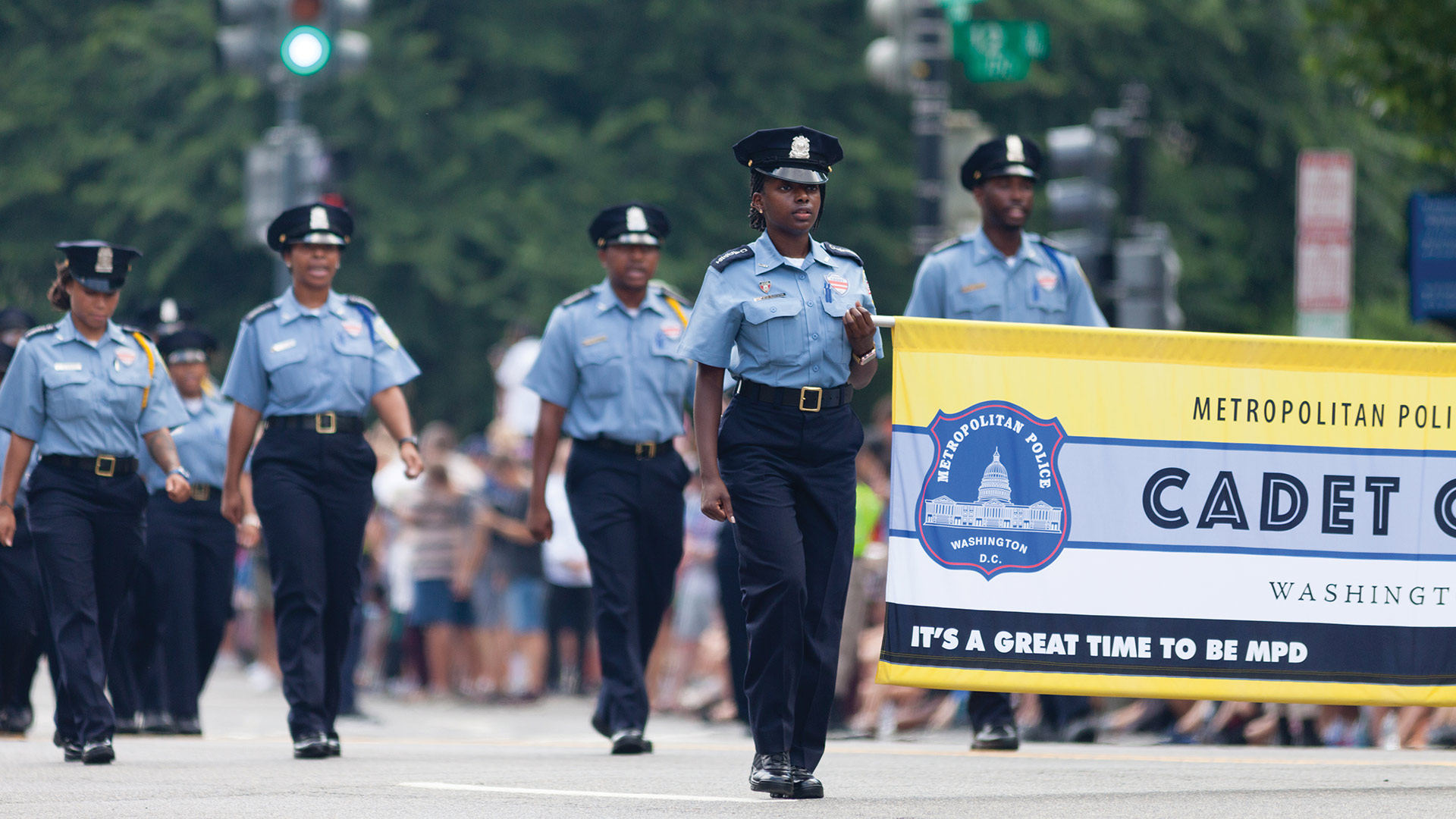
In my law enforcement career, spanning several decades and seven agencies, I can say without reservation that among my most valuable and satisfying experiences were the development and operation of several successful law enforcement cadet programs for youngsters roughly aged 14 to 17, which at the time were referred to as Explorer programs because of then-affiliation with the Scouting programs from my past agencies. Notwithstanding a glitch here and there, the programs turned out to be overwhelming successes in terms of community involvement, additional personnel resources, successful agency recruitment, greater agency span of capabilities, a whole bunch more tools in my agency tool chest and — of such great satisfaction to me personally — strengthening the personal, vocational and character profiles of hundreds of wonderful young men and women who had better lives because of their affiliation with my agencies. For the purposes of this article, the term “cadet” will be used for boys and girls aged 14 to 21 who are affiliated with a criminal justice agency and who participate voluntarily in activities oriented toward a possible law enforcement career.
Two key ingredients for a great cadet program
The first key and necessary ingredient is the right person and organization to run your cadet program! Some of the things we do are personality-dependent; developing and maintaining such a program is at the top of that list. A passion for developing kids, a love of our profession, an innovative and creative mind, strong character and exceptional common sense are essential requirements. Although the majority of my youth programs have gone very well, the few problems I did have were the consequences of putting someone in the coordinator’s position who was not a good fit — basically,
by assigning to the position a light-duty officer who I could spare from the regular workforce.
This initial practice did not yield the degrees of supervision and diligence that are essential for program success, instead just yielding a person who basically went through the motions and did not provide the enthusiasm, creativity and oversight that are essential for a cadet program to thrive and be successful. Ultimately, I found that cadet programs are typically most successful when led by a particular strong employee who manages the program as an additional duty, whether through overtime or temporary assignment. Once you have this strong employee in place, that person can typically recruit other employees to be of assistance as required, as well as utilizing qualified retirees or citizen volunteers.
The second of the two necessary key ingredients is an organizational support infrastructure unique to a youth cadet program, and this is where the development of a quality public safety cadet program just got easier — a lot easier! A recent publication by the U.S. Department of Justice’s Bureau of Justice Administration, Recruitment and Retention for the Modern Law Enforcement Agency, introduced the Public Safety Cadets (PSC), a nonprofit 501(c)(3)
organization that essentially provides an infrastructure and overlay available nationwide to law enforcement agencies desiring to establish a youth cadet program. The program, very reasonably priced and funded through participant dues, provides everything imaginable related to a justice-oriented youth program, from various standard operating procedures (SOPs) to personnel and administrative materials, training materials, legal and waiver materials, insurance and liability programs, and everything in between.
The PSC was founded by active and retired officers and business leaders dedicated to preparing young adults for careers and leadership in the public safety professions and is the only nationwide program of this nature. I recently had the opportunity to meet with PSC staff and was amazed at the thought and preparation that went into developing the program that they provide to agencies, which enables the rapid establishment of a “turnkey” youth cadet program with nothing left to the imagination. It was obvious that the PSC program benefited from the painful lessons that many disbanded Explorer/cadet organizations have experienced.
The difficulty and demise of similar programs
While there is no definitive source for the number of existing law enforcement youth programs, it is painfully obvious that there has likely been a tremendous decrease of such programs within the last two or so decades. Not surprisingly, this nationwide decline in the number of justice agency youth programs is related to the same two key ingredients previously discussed: the right person/organization in charge and the necessary agency infrastructure.
First, the person in charge of the program: in the majority of problematic situations, the local person in charge really wasn’t actually in charge! What turned out to be a systemic difficulty was the fact that most disbanded law enforcement youth programs were subordinate components of much larger nationwide organizations, and ultimately became enmeshed in the political and social challenges those parent organizations experienced. The last couple of decades have seen tremendous litigation in the areas of alleged political favoritism; social activism related to gender, ethnicity and sexual orientation; and past alleged misconduct of persons associated with the parent organizations. The chaos of these parent organizations spread into just about all of their subordinate youth justice programs, with litigation and disruptive community involvement that resulted in the heartbreaking disbandment of some really wonderful youth programs.
Second was the frequent lack of an organizational support infrastructure unique to youth organizations. As we know, chiefs and key personnel come and go, and when they leave, they take their institutional wisdom with them, including the lessons learned with respect to how best to develop and run an effective youth program. The “brain drain” of youth program wisdom has been heartbreaking.
The double whammy of being battered by external forces and the continuing diminishment of infrastructure and institutional knowledge has taken a devastating toll on youth programs throughout the nation and resulted in significantly fewer programs today than existed a mere decade ago.
Range of duties and responsibilities
While pushing the envelope a tad, I like to say the sky is the limit — almost! The big issues are legality, liability, training and the common sense and intellect of the person in charge. The following summarizes several successful cadet endeavors that I had developed and used with great success in one or more of the agencies where I have served.
Stakeout surveillance: My favorite and that in which I take special pride. Once a youngster demonstrated solid skills in knowing directions, techniques of observation and radio procedures, they became eligible for participation in stakeout assignments. These cadet teams were deployed in secure upper-story structures in areas where crime patterns had developed, especially automobile and business burglaries, and in areas such as shopping malls and parking lots. The only serious limitation was the availability of the cadets, so as not to interfere with school. During the operation, each observer (two to a location) remained in constant communication on a radio net with all other participants and the officers assigned exclusively to that operation. With their thermos of beverages, binoculars and radios, the kids loved it, and a whole bunch of bad guys went to jail. Typically, the high-ground youngster(s) would relay the initial observation to the nearby covertly placed supervising officer, who assumed the key observation and any subsequent arrest. No youngster was ever in jeopardy whatsoever and I don’t recall any youngster ever having to appear in court. No youngster was ever in close proximity of any suspect and the supervising officer was typically never more than a couple hundred yards from participating cadets. As a fun aside, because of an awards and decorations program developed for cadet apprehensions, some of the kids had so many awards they put General Patton to shame!
Pre-planned community organizations: For community parades, youth festivals and related activities, we could not have done an effective job without our cadets. Whether performing minor tasks or calling on the radio for a task requiring an officer, they were invaluable.
Unanticipated impromptu manpower needs: Another of my favorites was hailing available police cadets to the station or to a specific location for immediate manpower assistance. The big limiting factor for impromptu situations is safety. As an example, a crime scene or an expanded traffic situation can tie up a considerable number of officers, but these are tasks that can typically be performed by police cadets, unless in a dangerous environment. Calling available cadets to respond immediately to the station and then transporting them via van to the scene of an incident has freed up quite a number of officers in a short period of time in many instances. Certainly, the time of day is a factor for consideration.
Police cadets also have obvious value in natural or human-caused disasters, such as earthquakes, power disruptions, road closures and similar activities. In these types of incidents, many cadets may not be immediately available, but they may be available as the need for manpower persists. As I look back on some of the unique resource-intense situations in my career, I could not have achieved the results that occurred had it not been for cadets. I would be remiss if I did not mention the tremendous value of citizen volunteers, but I have to give a special nod to cadets because of their mobility and stamina.
Neighborhood enhancement duties: While it is clearly doable, I have a bit of a bias against using cadets for community enhancement if the need for enhancement is based on the troublesome behaviors of the residents. That said, a massive one- or two-day effort to put a new sparkle on a neighborhood, or something of that nature, can be an appropriate use of police cadets. In one of my departments, I had one kid per block in the downtown area on busy shopping days to keep the streets clean and provide helpful assistance to shoppers.
Supervision
The individual(s) supervising the cadets must have a high degree of common sense, so as to not permit kids to act like kids when performing police cadet functions. In the absence of a confidence level in the personal qualities of the adult supervisor, it is better to postpone the event instead of running the risk of inappropriate behavior. It is typically a best practice to have both a married adult man and a married adult woman physically present at police cadet activities. In reviewing the PSC materials, I noted very impressive SOPs for the entire range of activities their youngsters participate in.
Criteria for continued affiliation
For all of my police cadet programs, I mandated solid citizenship and academic maintenance of a B GPA for active participation. I have found that a B student is just a C student who tried a little bit harder.
Cadets as a recruiting tool
There is no better or more valuable source! In all of the agencies where I have served, police cadet programs have been a great recruiting source and a real advantage in the selection process. Some previous programs had age restrictions because of the rules of the parent organizations (Scouting, etc.). I recommend a range of appropriate opportunities to keep cadets engaged to age 21 for recruiting purposes, as kids can draft off into other directions during that critical age span of 18 to 21.
Not all great cadets end up being law enforcement employees, but the percentage is pretty high. They know what they are getting into, the profession has been able to see and evaluate their aptitude and character traits, and the backgrounds are typically pretty uncomplicated. Not all cadets aspire to be officers, but dispatch, crime scene and community service agents are all necessary possibilities.
Strengthening our communities
Generally speaking, the parents love it, the politicians love it, the municipal administrators love it, the press love it and, most importantly, in the overwhelming majority of instances, a young man or woman who succeeds as a police cadet will go on to have a more successful personal and professional life than would otherwise have been the case.
Summary and staying the course despite the glitches
I encourage my colleagues to break out, read and take seriously the Bureau of Justice document on Recruitment and Retention for the Modern Law Enforcement Agency (bja.ojp.gov/doc/recruitment-retention-modern-le-agency.pdf), and then look closely at the Public Safety Cadets. If ever there was such a thing as a win–win–win for our beloved profession, it is the development and operation of a law enforcement cadet program for all of our agencies.
Chiefs, do it right and the positive payback for your department, your community and your youth will be of immeasurable value. Will a glitch arise from time to time? Probably, but fixing that glitch, learning from our mistakes and making the program even better and stronger is what leadership is all about!
As seen in the April 2024 issue of American Police Beat magazine.
Don’t miss out on another issue today! Click below:






